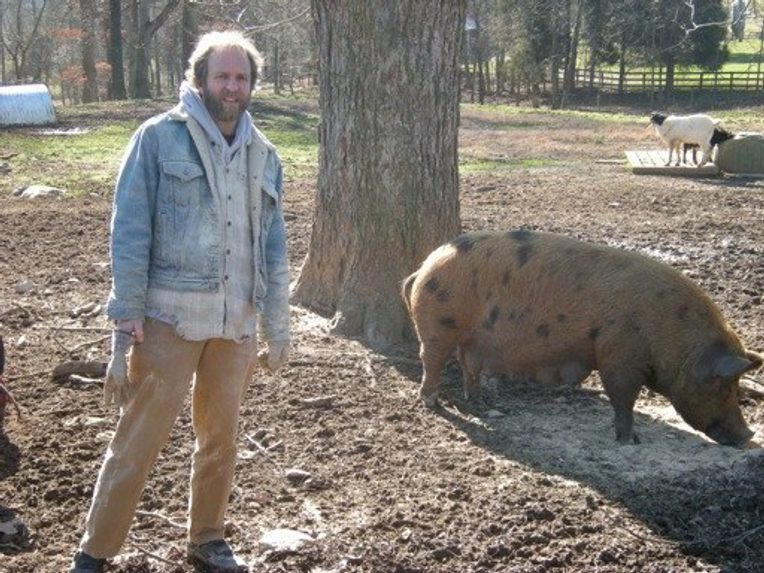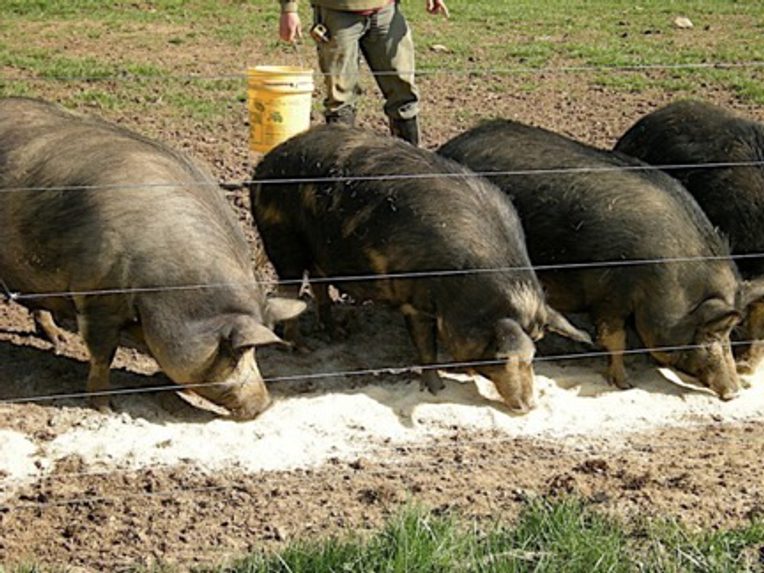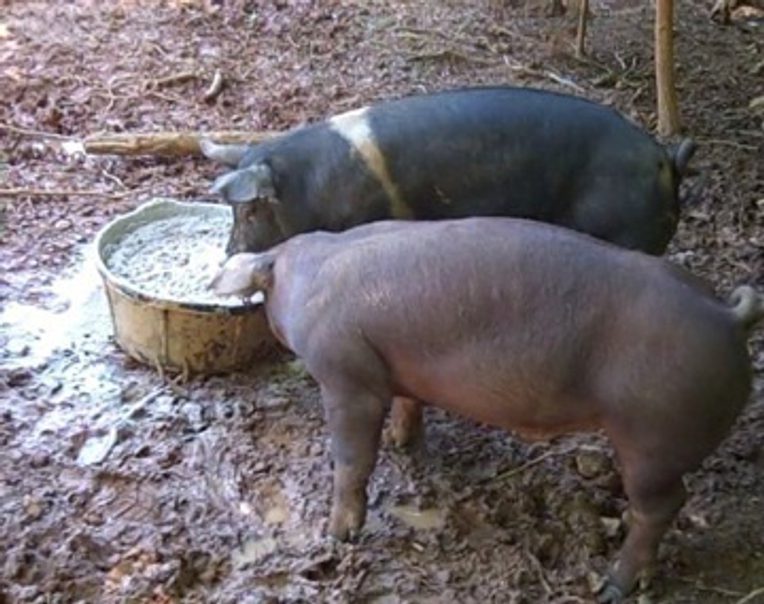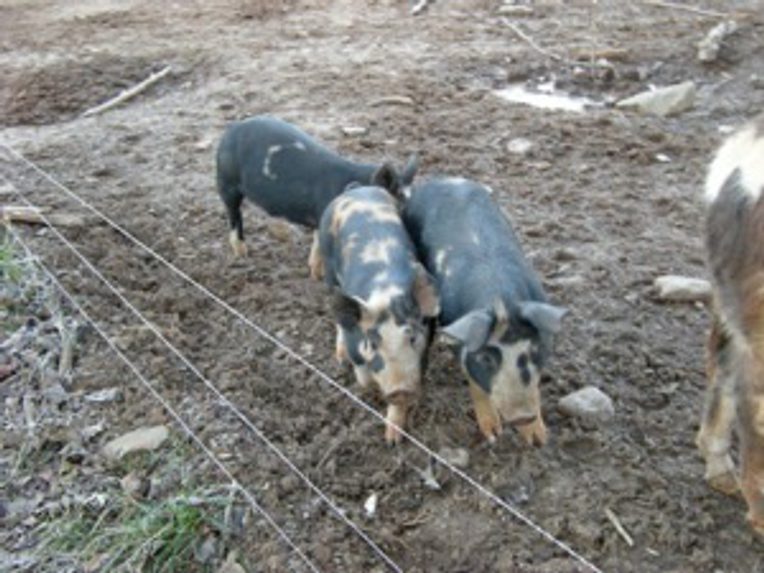This post builds on the research article “Making Pigs Local: Discerning the Sensory Character of Place,” which was published in the August 2011 issue of the Society’s peer-reviewed journal, Cultural Anthropology.

Interview With the Author
CA INTERN EMILY LEVITT: Is there a genetic level to what ‘heirloom’ means for these pigs? Or is the narrative of ‘heirloom’ hogs more dominated by a discourse of the social history of the breed? If there is a genetic angle to discussions of artisanal pork products in the Piedmont, how would this relate to your theory of the ‘sensory fields’ of pork appreciation? Would a genetic analysis of artisanal pork products work along with or at cross-purposes with your idea of the sensory fields of pork expertise?
BRAD WEISS: The relationship between the genetic characteristics of "heritage breeds" of pigs (and other animals), and the wider socio-cultural dimensions of a breed's historicity (including their husbandry, migrations, ecological adaptations) is a really interesting question. I'm currently hoping to work with members of the American Livestock Breed Conservancy (ALBC), who are developing a "Rare Breed Swine Initiative" designed to generate a model that can be used to expand the farming of rare breeds, as well as help to recover endangered breeds. This initiative, and the mission of the ALBC as a whole, really sees "heritage" as a kind of conjunction between biological and social content. On the one hand, they emphasize the importance of "preserving genetics," and using DNA analysis to trace the genealogical connections among pig populations. Indeed, the mission of the ALBC is to preserve the genetic "uniqueness" of specific breeds, so as to assure genetic diversity. At the same time, the ALBC understands "genetic uniqueness" in terms of breeding and "pedigree", which is to say, the particular husbandry practices through which a population of pigs can trace their ancestry to particular recognized pigs – or groups of pigs (e.g., the Ossabaw Island Hog herd). Moreover, in my discussions with ALBC researchers they've emphasized the ways that "heritage breeds" are recognizable as such in terms of the ways that they are concretely linked to specific times and places. For example, there are "hunches" about the ways that the American Guinea Hog might be derived from populations of the Essex hog, which was imported from England in the early 19th century to develop yet other breeds of hogs. In other words, if the Guinea Hog is a "genetically distinct" breed, this is only knowable by virtue of its historical relationship with other pigs, not merely by DNA testing. On a related point, when I asked what efforts were being undertaken to "conserve" the Mangalitsa pig (an animal that is today's "hottest pig," finding its way onto menus in Napa and Manhattan), I was told that this isn't an "American breed", so it's not a concern of the ALBC. So "genetic diversity" has an implicit national character.
Now what exactly does "genetic distinctiveness" mean? On the one hand, it means a population whose DNA stock would be "lost" if all the individuals in that breed died out. In this way, a rare breed is different from a recognized hybrid, whose populations could be reproduced by crossing different breeds over a number of generations. But at the same time, there's strong evidence that almost all domesticated stocks of pigs have a common genetic profile; there's a remarkably narrow range of genetic diversity among all pigs (in this way, of course, the discourse of "breeds" as a means of preserving "genetic diversity" is not surprisingly similar to discourses of human "races" that presume "genetic" differences that have no biological foundation). To take the Ossabaw Hog, again, there is evidence that these pigs have genetic connections with pata negro pigs that were, and are, raised in Western Spain. At the same time, the Ossabaws adapted to the island ecology of Ossabaw Island, and developed their distinctive characteristics. But are they genetically distinct from pata negros? Or merely a recognizable "breed" because of their shared features that emerge in this historical context - under conditions of colonialism, in the Sea Island ecology, as a feral (but once domesticated) population? When we say that the Ossabaw is "genetically unique" are its adaptations transformations in its DNA, or are they merely phenotypic variations that are assured through "pedigree" (that is, the legacy of pigs in the small, island-bound population reproducing within that population) and husbandry/ecological restraints?
These are really interesting and not easily answered questions. But they point to two useful frameworks, I think. The first is to recognize that whatever "genetics" are, they always derive their significance- they're knowable – from the ways that they are embedded in concrete places, conjunctions of time and place. A "heritage breed" is always a tellable narrative and a set of biological properties. Of course, sometimes these things can be at odds – maybe the Guinea Hog isn't an erstwhile Essex hog, and the genetic inquiry tells a different story than the tracing of pedigrees in the history of animal husbandry. But I don't think that "genetics" and "sensory fields" can be at cross-purposes, since genetics is, itself, a way of knowing that entails sensory experience. The larger point I'd make is that this (already too long!) discussion of breeds is really relevant for much wider cultural theory in the twenty-first century. Much of what anthropology is concerned with today are the ways that notions of "culture" are being deployed and codified in a host of different domains – from policy makers implementing "multicultural" education programs, to medical protocols that want to address "cultural" difference, to tourism enterprises that promote "cultural heritage." What I think is important, and perhaps unique, about these contemporary invocations of culture is the way they explicitly combine notions of social constitution and biological givenness. "Preserving our [fill in the blank] identity and heritage" almost always entails modes of making a wilful commitment to promoting recognizable features of difference (viz. language, ritual, cuisine, etc.) which differences are themselves seen to be unique, ineluctable dimensions of the very being of those who possess these features. In this way, the problem of "heritage breed" pigs raises questions about how and why "culture" has come to have this dual constitution, a grounding in both the social and the biological.

EL: If the Milltown farmers market requires that all farmers ‘make what they’re selling,’ at what point in the chronological chain does that ‘making’ have to take place? What ‘non-local’ products are brought into the process of creating ‘local’ pork (and other local products?
BW: Well, of course you've hit on a tricky - and touchy! – matter for the market, and, I would argue for the whole notion of "local food". The ethos of this particular market is that producers should forge a "connection" with consumers at the market. All of the products sold at this market, must be sold by their producers, who must be present as market vendors. This "connection" is part of the wider "Slow Food" agenda, as well; their mission is to redefine "consumers" as "co-producers". Clearly production is a source of legitimate, "real" value, while consumer(ism) is a kind of desecration.
The market regulations (and this is not unique to Milltown, but it is its longstanding commitment) require that producers, or members of their families, be present at the market when their goods are sold there. Each vendor gets a certain number of "substitute" days per year, when you can send a member of your staff (if you've got one) in your stead. So verification isn't just at the level of the products, but of the persons! At the product level it can be a little tricky. If I am selling produce – tomatoes, or carrots – what does it mean to say that I've grown them myself? Do I have tomato plants that I grew from seeds? Or can I acquire seedlings from a nursery and grow the plants until they fruit, and sell what they yield as "locally grown"? What nurseries can I use? In some instances, a market may want to be flexible and permit farmers that have had a crop wiped out by some blight to incorporate a certain number, or percentage of purchased seedlings to cover those losses. To be honest, I can't specify what the requirements are (for one thing, they are changing and negotiable), but I can say that any market committed to such "locality" and "connections" is going to have to stipulate "how much" is local, and what counts as a local product of input.
With livestock – pigs, but also poultry – these questions are especially problematic. Raising plants from seeds is a little time consuming, but not terribly difficult. Breeding pigs, and even chickens, though, demands some real expertise that even experienced livestock farmers don't always have. You have to maintain an adult breeding stock that's much larger than the pigs you're going to bring to market, which means you need to have the space to keep them, as well as the labor and (I can't emphasize this enough!) expertise to know when and how to move a 600 pound boar into and out of a sows' pen before and after the breeding is done. For this reason, a great many pig farmers raise what are called "feeder" pigs, or "weaner" pigs, meaning pigs ready to feed once they've been weaned. These pigs are purchased from pig breeders (most of whom raise their own hogs for market, as well) to be raised farmers who want to market pork. At what point does a pig get too big to be considered a pig that the farmer has actually "produced"? Can I sell pork from a "feeder" pig in North Carolina that I purchased from a breeder in Virginia? How does a market verify that? What about the animals' feed? Does it have to be locally grown grain? That is a huge burden to meet for most livestock farmers, and (in my experience) extremely uncommon. With chickens the issues are even more contentious. Many farmers object to poultry that isn't bred from one's own livestock, because many of the eggs, chicks, and pullets are provided by industrial producers; raising Cornish Cross chickens with eggs from a Tysons or Perdue plant is seen to defeat the purpose of promoting sustainable agriculture by many farmers.
Again, exactly what the parameters and their limitations are (at what age must pigs be acquired? From which breeders?, etc) is going to have to be specified, and verified. The Milltown market, for example, requires livestock producers to producer bills for the feed and the juvenile animals acquired – if they were purchased- to document their provenance of production. But the issues are going to have to be addressed by any market that touts its "local" bona fides. It's worth noting, of course, that not all markets do. Any number of farmers markets include industrially grown meats and produce that - for whatever reason – couldn't be shipped, or sold through wholesalers, so, for example, a state run farmers market may serve as a kind of "dumping ground" for many goods that never make it to the grocery store.

EL: How does this process of creating and representing a locality through food work when the products are being sold outside of the local area, i.e. the Piedmont?
BW: The idea that the "sense of place" generated by the embodied practices I've described in the article can "translate" as "local" products (say, pork) are sold outside their "home" localities is a major dimension of the marketing of foods, and especially artisanal foods. The discussion of the wine shop in my paper shows the way that "locality" works as a kind of, what I called, a "transposable framework." I'm looking now at a menu from David Chang's Momofuku in the Village. It's not only a sacristy to pork fat, but it also makes use of this same transposable framework of locality, listing the producers of its County Ham offerings by name,followed by the town in which the ham maker is located (e.g "Meacham Country Ham (Sturgis, KY)). It hasn't, to my knowledge, included "Haw Creek Pork" on its menu, but it certainly could (and other NYC restaurants have). These kinds of frameworks are part of what Lefebvre calls "the representation of space," ways of codifying places as models, or schema. They conceive of places as fixed regions, and can be ways of planning , or designing (hence, promoting, or marketing) a place. My argument in the article is not that "the Piedmont" has become such a recognizable representation – we might even call it a brand, in my view – in the way that Burgundy has for wines, or Parma has for cheese (or ham!). It's rather that the spatial practices found in the Piedmont make it recognizable as a place (which for some, but by no means all, is codified as "the Peidmont) for those interested in "local foods". That is, whatever "local foods" is, it's discernable through the spatial practices of the Piedmont, or the sensory field I've described for those interested in "local food."
Now, does that sensory field translate across localities? How do "spatial practices" articulate with "representations of space" we might say? I'm not entirely sure of how this happens, or to what extent it is happening with pork. For some wine drinkers, of course, a Burgundy has very specific qualities that a discerning drinker will recognize. But even in the absence of that discernment, its still imperative that wine be sold by reference to its origine, because this mode of place based reference serves as a kind of assurance of quality; even if I have no idea what a wine tastes like, I'm more likely to think that it tastes good if I know (not who made it, or under what conditions, but) where it's from. The fact of emplacement itself seems to be the prerequisite for that quality, regardless of the consumer's tastes, or knowledge. Obviously pork is entering that realm, as well, if "Sturgis, KY" can serve as a means of providing some kind of assurance for folks who eat ham. I have no doubt that "Milltown, NC" could be just as effective. But this doesn't really mean that the sensory field that provides the "taste of place" embedded in Piedmont ham is readily transportable to New York or Napa, or wherever just because these representations can be used effectively. I think the representation indexes a set of practices that are presumed to underlie that "locality" that’s available to be represented. "If that ham has a 'place" it must taste good" seems to be the logic. And, of course, New York and Napa and where-have-you each has their own range of embodied, sensory spatial practices that includes (for many) an awareness of other places that are understood to have their own characteristics. In other words, practices and representations can overlap, and even support one another. Good representations can foster specific spatial practices ("hey, Maytag blue cheese is hot in Chicago, let's make some artisanal stuff !), or certain forms of discernment; and some spatial practices may lend themselves to being translated into specific representations. There's a lot of interest in "local foods" that makes particular places "travel well", as named regions; but an interest in "local computer chips" doesn't quite carry with it a "sense of place." In short, places, their qualities (like tastes) and the way they can be known (or represented) are contingent. It takes a lot of cultural work to sustain them.

Additional Works
2009 Street Dreams and HipHop Barbershops: Global Fantasy and Popular Practice in Urban Tanzania. Indiana University Press.
2003 "Sacred Trees, Bitter Harvests: Globalizing Coffee in Colonial Northwest Tanganyika." Social History of Africa Series. Portsmouth, NH: Heinemann.
1996 The Making and Unmaking of the Haya Lived World:Consumption, Commoditization and Everyday Practice. "Body, Commodity, Text" Series. Durham and London: Duke University Press.
